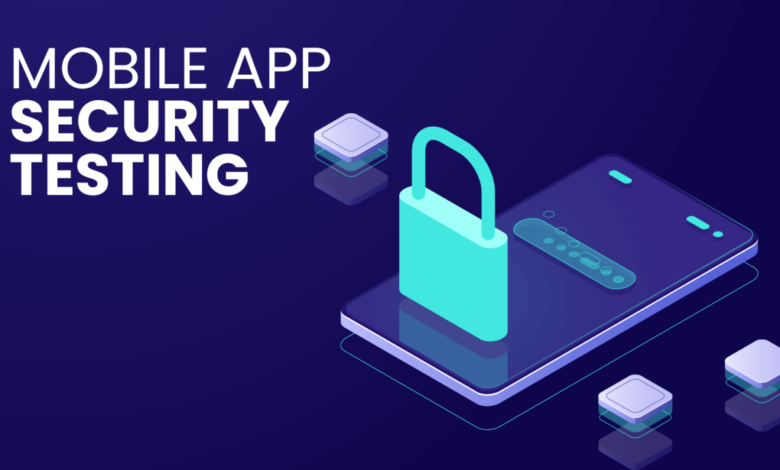
In the fast-paced world of mobile applications, ensuring user data security and continuing your app’s unity is most important. As technology progresses, so do the developing threats to mobile app security. This complete guide searches into the intricacies of security testing for mobile apps and inspects the importance, challenges, best practices, and future trends in this critical domain.
Mobile applications have become basic to our daily lives and control sensitive data ranging from personal information to financial transactions. Consequently, the need for robust security testing has never been more major. In this age of cyber threats, a proactive approach to securing mobile apps can distinguish between a trusted app and a potential security contravention.
Understanding Mobile App Security
Search the intricate realm of mobile app security, exploring the common threats and sensitivity that pose risks to user data. Gain insights into the significance of robust security measures to secure against evolving cyber threats and ensure the integrity of mobile applications.
Common Security Threats
Mobile app developers face many security threats, including data breaches, viruses, and unofficial access. Understanding these threats is the first step in structuring a robust security testing strategy.
Risks Associated with Mobile App Vulnerabilities
Sensitivity in mobile apps can lead to extreme consequences, such as compromised user data and damaged brand reputation. Identifying and addressing these risks is essential for the overall security posture.
The Significance of Security Testing
Unveiling the Critical Role of Security Testing: Explore how meticulous security testing protects sensitive user data from unauthorizedness and potential breaches. Delve into its pivotal role in building and sustaining user trust, ensuring the robustness and reliability of mobile applications in an era of escalating cyber threats.

Ensuring Data Protection
Security testing acts as a shield, safeguarding user data from unauthorized access and potential leaks. This section explores the role of security testing in maintaining the privacy and unity of sensitive information.
Building User Trust through Secure Apps
In an era where trust is valuable, users are likelier to engage with apps prioritizing security. Discover how security testing contributes to building and maintaining user trust.
Key Components of Mobile App Security Testing
Explain the core elements of mobile app security testing: Search for the crucial aspects of static analysis, dynamic analysis, penetration testing, and code review. Uncover the methodologies that secure apps against vulnerabilities, ensuring a complete and effective approach to securing sensitive data in the dynamic landscape of mobile application development.
Static Analysis
Static analysis involves examining the code without achieving it and identifying vulnerabilities at the source. Learn how this method plays a crucial role in the early detection of potential security issues.
Dynamic Analysis
Dynamic analysis requires testing the app in a runtime environment and simulating real-world usage scenarios. This section highlights the emotional aspects of security testing and its relevance in a dynamic mobile landscape.
Penetration Testing
Penetration testing, or social hacking, involves artificial cyber-attacks to recognize weaknesses. Explore how this proactive approach helps developers patch sensitivity before malicious actors exploit them.
Code Review
Code review is essential to security testing, ensuring the app’s codebase adheres to best practices. Uncover the significance of meticulous code scrutiny in enhancing overall security.
Challenges in Security Testing for Mobile Apps
Navigating Obstacles in Mobile App Security Testing: Examine the complexities posed by the ever-evolving nature of security threats, device atomization, and the demand for continuous testing. Discover strategies to overcome challenges and devise effective security measures, ensuring robust protection for mobile apps against cyber risks.

Evolving Nature of Security Threats
As technology progresses, so does the project of cybercriminals. This section addresses the challenges created by the ever-evolving landscape of security threats and the requirement for adaptive security testing.
Device Fragmentation
The multitude of devices and operating systems adds complexity to security testing. Discover strategies to overcome the challenges created by device atomization in the mobile ecosystem.
Continuous Testing Requirements
Mobile apps are in a constant state of development, with continuing updates and feature improvement. Understand the importance of sustained testing in keeping pace with the productive nature of mobile app development.
Best Practices for Effective Mobile App Security Testing
Guiding Principles for Optimal Mobile App Security Testing: Uncover the best practices for complete security testing. From regular updates and encryption to user-confirm protocols, explore the strategic process of enhancing the effectiveness of security testing, ensuring the resilience of mobile applications in the face of progressing cyber threats.
Regular Updates and Patches
Frequent updates and patches are crucial to addressing newly discovered sensitivity. Learn how staying proactive with updates can significantly enhance your app’s security.
Encryption and Secure Data Transmission
Encryption is the basis of mobile app security. Explore the role of encryption in protecting data during transmission and the best practices for performing secure communication channels.
User Authentication Protocols
User authentication is a critical layer of defense against unofficial access. This section outlines best practices for performing robust user authentication protocols to safeguard user accounts.
Tools and Technologies for Mobile App Security Testing
Exploring Tools and Technologies in Mobile App Security Testing: Explore the available resources, together with the OWASP Mobile Security Testing Guide, Appknox, and Mobile Security Framework (MobSF). Learn how these cutting-edge tools allow developers to identify and reduce sensitivity, ensuring robust security measures throughout the mobile app development lifecycle.

OWASP Mobile Security Testing Guide
The OWASP Mobile Security Testing Guide provides a complete advantage for the inventor to check out and increase the security of their mobile apps. Explore the means, features, and benefits of this necessary tool.
Appknox
Appknox is a powerful mobile app security testing platform. Uncover how this tool streamlines the testing process, helping developers identify and address vulnerabilities efficiently.
Mobile Security Framework (MobSF)
MobSF is an open-source mobile app security examination support. Learn how this tool supports various testing methodologies, making it a valuable asset for developers committed to app security.
Real-life Examples of Successful Security Testing
Illuminating Success Stories in Security Testing: Search real-life cases, such as banking app fortification and e-commerce platform resilience. Explore how proactive security testing has safeguarded sensitive data, mitigated vulnerabilities, and enhanced customer trust in diverse sectors, providing tangible examples of effective security measures.”
Case Study 1: Banking App Security Testing
In the financial section, security is non-negotiable. Explore how a leading bank successfully employed security testing to secure its mobile banking app against capability threats.
Case Study 2: E-commerce App Vulnerabilities
E-commerce platforms handle extensive amounts of sensitive customer data. Delve into a case study to display how a proactive approach to security testing helped an important online strongest match address vulnerabilities and enhance customer trust.
Benefits of Proactive Security Testing
Unlocking the Advantages of Proactive Security Testing: Discover the benefits beyond safeguarding data. From cost-effectiveness in reducing potential financial losses to encouraging enhanced brand reputation, explore how an energetic approach to security testing provides overall business resilience and customer trust in the dynamic landscape of mobile app development.
Cost-Effectiveness
Investing in proactive security testing might appear like an additional cost, but in the long run, it proves to be a cost-effective strategy. Identifying and addressing vulnerabilities can save businesses from potential financial disappearance.
Enhanced Brand Reputation
User trust is closely tied to the reputation of your brand. Learn how proactive security testing contributes to a positive brand image, encourages customer allegiance, and attracts new users.
Future Trends in Mobile App Security Testing
Expect the Future: Trends in Mobile App Security Testing: Search into cutting-edge advancements, including the combination of Artificial Intelligence and Blockchain technology. Explore how these evolving trends rewrite the landscape of mobile app security testing, providing insights into the next border of solid protection against cyber threats.

Artificial Intelligence Integration
Artificial Intelligence (AI) is testing. Explore how AI can increase the efficiency and success of mobile app security testing projects and reduce threats in real time.
Blockchain for Enhanced Security
Blockchain technology is similar to cryptocurrencies. This section explores the potential of blockchain in secure mobile app security, providing a localized tamper-resistant foundation.
Common Mistakes to Avoid in Mobile App Security Testing
Guide Clear of Pitfalls: Avoiding Common Mistakes in Mobile App Security Testing: Examine general errors, such as failure to provide third-party integrations and the lack of regular security audits. Uncover strategies to sidestep these problems, ensuring a comprehensive and effective security testing approach for mobile applications in a rapidly evolving digital landscape.
Neglecting Third-Party Integrations
Third-party integrations can introduce vulnerabilities. Understand the risks associated with third-party components and strategies to reduce potential security threats.
Lack of Regular Security Audits
Consistent security audits are vital for maintaining a secure mobile app. Learn the consequences of neglecting regular security audits and how to incorporate them seamlessly into your development lifecycle.
User Education on Mobile App Security
Empowering Users: Education on Mobile App Security: Highlighting the pivotal role of user awareness in bolstering overall app security. Explore the significance of educating users on best practices, creating a collaborative approach to security, and providing practical tips for secure mobile app usage. Enhance user understanding and engagement to fortify the mobile app ecosystem against potential threats.
Importance of User Awareness
Users play a crucial part in mobile app security. Explore the significance of educating users on Security best practices, creating a collaborative approach to app security.
Tips for Secure Mobile App Usage
Empower users with practical tips for ensuring their mobile app usage is secure. From password management to attempts, these tips enhance user awareness and contribute to overall app security.
Regulatory Compliance in Mobile App Security
I adhere to Regulations: Mobile App Security Compliance: Unveiling the impact of GDPR and other relevant regulations on developers. Search into the importance of aligning with legal requirements to safeguard user privacy and ensure regulatory compliance in the dynamic landscape of mobile app security.
GDPR and Its Implications
The General Data Protection Regulation (GDPR) has far-extended suggestions for mobile app developers. Understand how compliance with GDPR and other appropriate regulations is essential for protecting user privacy.
Other Relevant Regulations
Explore additional regulations that impact mobile app security and the importance of staying abreast of legal requirements in various regions.
Security Testing in the App Development Lifecycle
Integrating Security Throughout Testing in the App Development Lifecycle: Explore the seamless fusion of security testing with DevOps, ensuring a balanced approach between speed and protection. Understand the significance of continuous monitoring and improvement in adapting security measures to the evolving threat landscape during the entire app development lifecycle.

Integration with DevOps
Integrating security testing seamlessly into the DevOps pipeline is essential to balance speed and security. Discover strategies for effective combination and the benefits of a DevSecOps approach.
Continuous Monitoring and Improvement
Security testing is not a one-time expect. Learn the importance of continuous observation and improvement and adapting security quantify to the developed threat landscape.
Conclusion
In conclusion, the security testing landscape for mobile apps is energetic and challenging, requiring a proactive and multifaceted approach. By understanding the significance of security testing, adopting best practices, and continuing side by side with appearing trends, developers can create mobile apps that users can trust with their sensitive information.
FAQs
How often should security testing be conducted for a mobile app?
Security testing should be managed regularly throughout the development lifecycle and whenever remarkable updates or changes are made to the app.
Can security testing warranty 100% security for a mobile app?
While security testing significantly expands the app's security, it cannot guarantee 100% security. It is essential to stay attentive, update security, and evaluate regularly.
Are there specific regulations for mobile app security testing?
Yes, regulations such as GDPR have suggestions for mobile app developers. It's crucial to be aware of and follow relevant rules to protect user privacy.
What role does user education play in mobile app security?
User education is vital in creating a collaborative approach to security. Educated users are likelier to follow best practices, enhancing overall app security.








